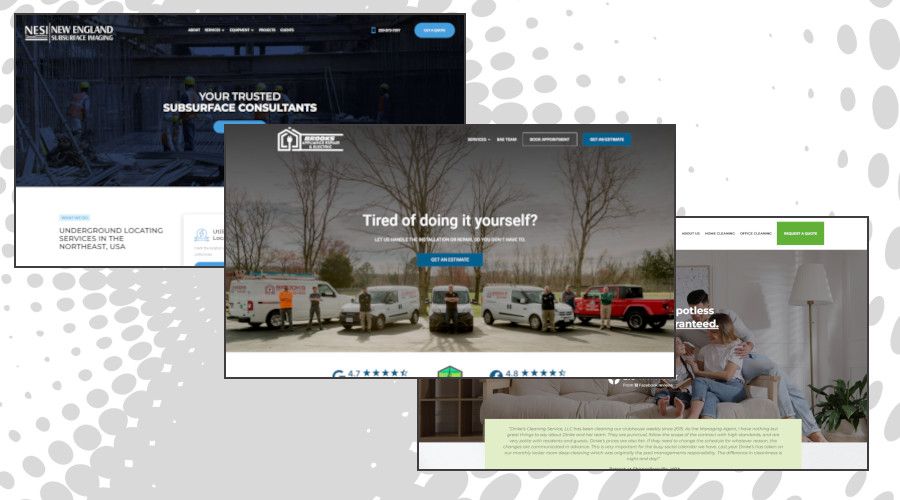A great website isn’t meant to be static – it should grow and evolve to meet the changing needs of its users. Trends change as new technology comes out, design preferences come and go, and the way we do business evolves.
Over the last 5+ years, our team at Websites for Anything has noticed an extraordinary amount of change. We’ve seen an explosion of website traffic and higher expectations when it comes to a person’s digital experience. An old, outdated website doesn’t just slow down your business growth. It can actively work against you when it comes to winning new customers.
Does your website meet the needs of the modern day user, or is it stuck in the past? Here are a few major shifts in website trends – and how to make sure your site isn’t holding you back:
1. Easy Access without Extra Clicks
Life is BUSY, and people expect technology to keep up with their active lifestyles. For many of us, that means spending less time sitting in a dedicated office and more time visiting websites, checking messages, and conducting business from our phones. The rise of mobile website traffic, combined with decreasing time-on-site across ALL devices show us one thing – people want good content and they want it now.
Years ago, it was trendy for websites to have involved features like sliders on the home page, click-to-open boxes of information, and scrolling testimonials. These days, people aren’t going to wait around for your slider to refresh. They don’t watch till the fourth testimonial in the carousel pops up. They expect to see your best content right away – and if you make them wait, you risk losing them to the next guy.
Want to make sure your future website visitors have easy access to your business information with an enjoyable website experience? Give your site a quick review: double check if content loads quickly, text is positioned well, and people can easily reach the main points of your business without excessive scrolling or clicking. Do you have compelling copy hidden away on a slider or carousel? Consider choosing your main point and deleting the rest.
2. Lose the ‘Marketing Speak’
Have you ever read a website ‘about’ page that seems to say everything and nothing all at the same time? How about a site with so many buttons and requests that you don’t know what to click next? Years ago, people wanted to fit as much content as possible into their sites. But these days, users are looking for digestible, helpful content that answers their most pressing questions.
How quickly does your site let people know what you do? No, not in fancy marketing speak – do you actually list your services in a way that tells people “yes this person can do what I need”?
Does your website make it easy or difficult for people to take action and contact your business? Do you have a prominent call-to-action that helps them out, or is it buried in pages of content?
Show your potential customer you respect them and their time with website content that puts THEM at the center. Prioritize content that answers questions they care about. Avoid stuffing unnecessary keywords or background information into the copy. Use graphics and visuals that enhance the text on your website, rather than distract from it. From time to time, we as business owners need to remember our site visitors are more than consumers. They’re busy parents, neighbors, and families just like us!
3. Security + Upkeep
One unfortunate byproduct of increased web traffic is the growing number of online scammers and hackers. Many small businesses have fallen victim to phishing attacks, website takeovers, and other cybersecurity disasters. Whether your website has a simple contact form, or collects extensive client data, it’s imperative you keep your users’ information safe.
Not only are secure sites beneficial for you and your users – it’s also increasingly important to Google and other search engines. Sites that don’t have an SSL in place, or ones that are stored on cheap, shared servers may receive less attention online than their well-maintained, secure competition.
So what can you do to protect your site? First, ensure your SSL is in place, up to date, and encompasses all pages on your site. Next, add reCAPTCHA and other form security to screen for bots or other automated attacks. From there, check in with the back-end elements of your site, and make sure no old themes, outdated plugins, or other features are leaving you vulnerable to an attack. Not sure how to take care of this important technical maintenance? We’ve got you covered with advanced website support!
Is your site stuck in the past? We can help! If your site hasn’t been updated within the last 5 years, you may be missing out on prime opportunities to engage with your ideal clients. Get your business back up to speed with a free website review video, where we’ll the strengths and weaknesses of your site. We’ll also show you the 16 key pieces that belong on EVERY small business website, with other tips and ideas tailored to making sure your website is successful in 2023 and beyond.

